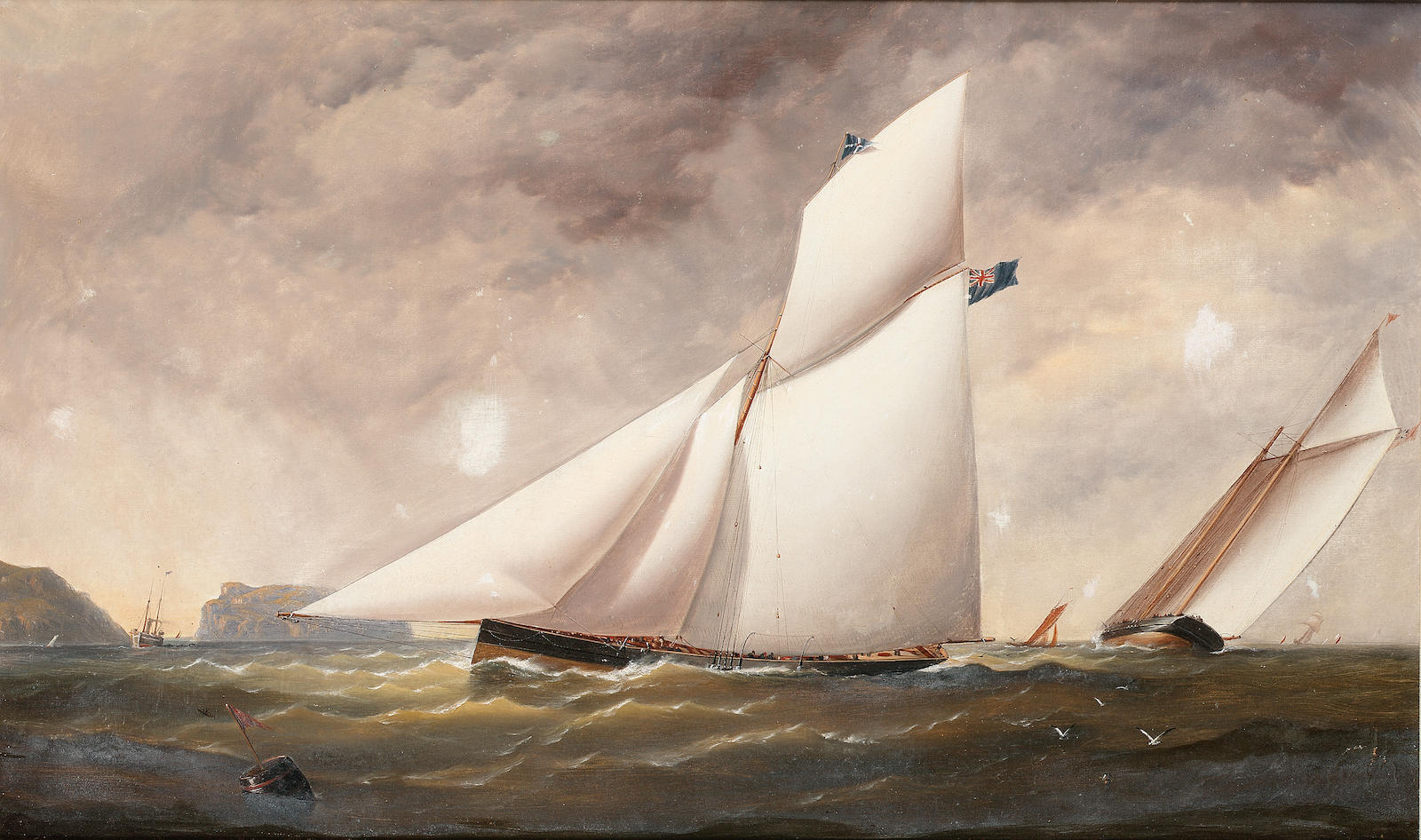
|
REF : 0
EDITION : 1851
DATE : 1851
COURSE : 0
DESCRIPTION SITE :
signed 'H.Forrest' (lower left), oil on canvas
FOOTNOTES
Before the Prince of Wales’s legendary “Britannia” burst upon the yachting scene in 1893, the nineteenth century’s most celebrated cutter had been the “Arrow”. Built in Inman’s yard at Lymington in 1821 for Mr. Joseph Weld of Lulworth Castle, Dorset, she was measured at 85 tons and was 61½ feet in length with an 18½ foot beam. More interestingly perhaps was the fact that she was largely the product of her owner’s ideas of design at a time when he was one of the most vociferous champions of the cutter rig. In the opinion of British Yachts and Yachtsmen (publ. 1907), “there is no more conspicuous figure in these early days [of yachting] than Mr. Weld” and there is no doubt that he was one of the earliest salt-water yachtsmen in the modern sense. He was sailing competitively as early as 1800 and was amongst the founding fathers of the Royal Yacht Squadron, originally called ‘The Yacht Club’, when it was established in 1815. After numerous successes with several boats, latterly his 60-ton cutter “Charlotte”, Weld replaced her with “Arrow” in 1821 and, from the outset, his new cutter proved more than a match for all-comers, even those of significantly higher tonnage. In an exciting race from Cowes to Swanage Bay and back in July 1825 for a wager of £500, “Arrow” was only narrowly beaten by Lord Anglesey’s “Pearl” yet the winner was nearly 20 tons more in burden. When matched against yachts of comparable size and tonnage, “Arrow” was unbeatable and her first real triumph came in 1826 when she won the £100 gold cup at the [Royal] Yacht Club’s annual regatta; that year marked the inauguration of cup-racing at Cowes and thus the honour of winning the very first cup ever offered by the Royal Yacht Squadron fell to Mr. Joseph Weld and “Arrow”. It was an historic victory and the first of many in what was to prove an astonishingly long career.
Anxious to improve on “Arrow’s” success with an even larger cutter, Weld sold “Arrow” after the 1828 season – a decision he came to regret bitterly – and she was purchased by George Ackers, a fellow club member. Although Ackers kept her for five years before selling her to Lord Godolphin in 1834, it appears that she was often laid up for long periods and might never achieve her real potential. Eventually, in 1846, she was bought off a mudbank for a bargain price by Mr. Thomas Chamberlayne, another R.Y.S. member, who not only restored her but also slightly lengthened her. With the work completed, her reappearance at Cowes in 1847 marked the beginning of a remarkable renaissance during which she became arguably the best-known yacht of her day. In August 1851, she was one of the flotilla to sail around the Isle of Wight against “America”, the notorious challenger from New York; history records that this famous race was won by “America” but it fails to note that had not “Arrow” run ashore at Ventnor, the entire history of international yachting might have been different. In fact, when “America” returned to Cowes in 1852 she was soundly beaten by “Arrow” in an identical race for the Queen’s Cup at Ryde Regatta with “Arrow” then going on to win the other Queen’s Cup at Cowes the same summer, the latter in one of the quickest times on record. In 1854, “Arrow” took the cutter’s prize at the Royal Southern Regatta, the prestigious silver salver at the Royal Victoria Regatta and Prince Albert’s Cup at Cowes; it was a memorable season and she continued this winning streak over the coming years, winning the Prince Consort’s Cup at Cowes in 1860, the Squadron Cup in 1863, Mr. Salt’s Prize in 1865 and the Town Cup in 1869. Still competing and frequently winning in the next decade, she won at Dover in 1876 until finally taking an incredible ten prizes out of seventeen starts in 1879, her very last season.
The [Ryde] Town Cup of 1879 marked “Arrow’s” farewell appearance in the Solent, and it proved a triumphant finale to an altogether brilliant career. Pitched against a seemingly invincible opponent, the brand-new “Formosa”, “Arrow” beat her in an epic race which electrified all those who witnessed it; Bell’s Life, the contemporary journal, called it “the greatest victory the old ship has achieved in the half-century of her existence”. Rhetoric perhaps but, fifty-eight years after she was launched, the only English yacht to claim she had never been beaten by the great “America” had shown herself, even at the last, to be the most formidable cutter afloat. Thereafter retired but not forgotten, she has been described as “the epitome of the first sixty years of salt-water racing”
LICENCE :
Public domain
| LIENS VERS CE DOCUMENT | ||||
| SITE | LARG | HAUT | ADRESSE | |
 |
Bonhams | 1600 | 946 | https://www.bonhams.com/auctions/10191/lot/49/ |
 |
Encore Editions | 1000 | 801 | http://www.encore-editions.com/capt-james-haughton-forrest-the-royal-yacht-squadrons-famous-cutter-arrow-under-full-sail/poster |